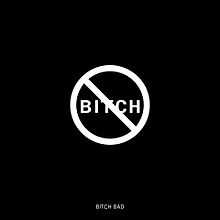Bitch Bad
| "Bitch Bad" | ||||
|---|---|---|---|---|
 | ||||
| Single by Lupe Fiasco | ||||
| from the album Food & Liquor II: The Great American Rap Album Pt. 1 | ||||
| Released | June 25, 2012 | |||
| Format | Digital download | |||
| Recorded | 2012 | |||
| Genre | Hip hop, alternative hip hop, conscious hip hop | |||
| Length | 4:51 | |||
| Label | 1st & 15th, Atlantic | |||
| Writer(s) | Wasalu Jaco, Dominic Jordan, Jimmy Giannos, Jason Boyd | |||
| Producer(s) | The Audibles, Jason Boyd | |||
| Lupe Fiasco singles chronology | ||||
| ||||
"Bitch Bad" is a song performed by rapper Lupe Fiasco. It is the second single off his album Food & Liquor II: The Great American Rap Album Pt. 1. It was released on June 25, 2012.[1] "Bitch Bad" tackles misogyny in hip hop culture and the use of the word "bitch" in rap music, the effects of these things on society and children, and the psychological concept of the Madonna-whore complex.[2]
Lyrical content
In the first verse of the song, Fiasco uses the imaginary situation of a little boy listening to his mother sing along to the radio to illustrate how casual use of the word "bitch", especially by women themselves, can lead to skewed perceptions of the word and its connotations. The hook then puts forward a hierarchy of terms referring to women in which "bitch" is "bad", "woman good" and "lady better".
The second verse explores how objectification of women in music videos can have a negative influence on "malleable" and "un-mentored" young girls, noting that "they don't see a paid actress, just what makes a bad bitch". In other words, these young girls have come to associate the image of a "bad bitch" - a promiscuous young woman - with their "favourite singer", and assume that this is what they should aspire to become.
Finally, these two threads are brought together in the third verse when "the little boy meets one of those little girls" and their contrasting misconceptions of the word "bitch" collide. The boy has grown up associating the term with his mother, whom he respects, whereas the girl sees it as representing a sexual ideal. Fiasco makes a play on the phrase "bad bitch" by implying that the boy sees the girl as a "bad" example of a "bitch", which in his eyes means "woman". Due to this, he is uninterested in her sexually; ironic considering that it was in an attempt to appeal to men that she covered up her "nice and smart" personality with a "bad bitch" facade. Fiasco notes the double meaning that the word holds even for the girl: it can be an insult "if you say it the wrong way", yet she still aspires to become a "bitch" herself - "What a double entendre".
Music video
The music video was released on August 22, 2012 on MTV's RapFix Live and premiered on YouTube the same day. The video was directed by Gil Green. He dedicates the video to Paul Robeson and the “many black actors who endured the humiliating process of blackface in America". MDMA made a cameo appearance singing his lines in the end of the video.
Critical reception
The song has garnered praise from artists such as Janelle Monae, Talib Kweli, Jill Scott, and Kanye West, who even posted the video on his Twitter. The song, however, was not well received by Spin Magazine, who wrote that the song and the video were "mansplaining...half-baked conscious hip-pop...muddled, measly-mouthed missive...reckless social commentary...poorly thought-out grab for attention", and claimed that Lupe has a "moronic lyrics-over-everything attitude" which led him on a Twitter rant and also led him to encourage fans to boycott the magazine.[3] The song drew further ire from various commentators and artists, centred on its YouTube video. Most notably, the concept of "Bitch Bad," and Lupe's statements on the state of Black America as a whole, sparked a late summer "Twitter war" between Fiasco, his fans, and a previously unknown artist named Speed on the Beat.[4]
Charts
| Chart (2012) | Peak position |
|---|---|
| US Billboard Bubbling Under Hot 100 Singles | 11 |
| US Hot R&B/Hip-Hop Songs (Billboard) | 62 |
References
External links
| ||||||||||||||||||||||||||